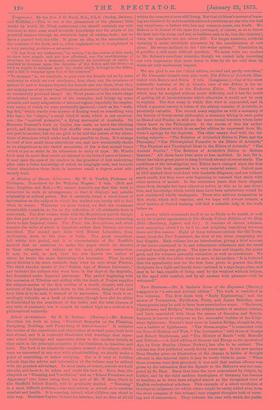Trespassers. By the Rev. J. G. Wood, M.A., F.L.S. (Seeley,
Jackson, and Halliday.)—This is one of the pleasantest of the pleasant little works by which Mr. Wood endeavours (we should certainly say with success) to filter some small scientific knowledge into the minds of his youthful readers through an attractive layer of curious facts ; but we have a quarrel with the title. It gives no idea, to the uninitiated, of the contents of the book, and is, when explained—as it is explained in a vary amusing preface—a misnomer :—
" It has been my endeavour," be writes, "in the course of this work, to show how simple, and yet bow effectual, are the modifications of structure by which a mammal, ordinarily an inhabitant of earth, is enabled to trespass upon the domains of the fishes and the birds,—a bird or reptile to trespass upon the realm which belongs to the fishes, and a fish to trespass upon that of the mammal"
"To trespass" is, we conclude, to pass over the bounds sot us by some authority to which we owe obedience ; how, then, can the creatures of nature be said to trespass beyond the bounds she sets them, when they are making use of the very "modifications of structare"with which she has so wonderfully provided them ? Mr. Wood passes over the whole range of animated nature in search of his examples, and brings up some animals, and many adaptations of internal organs (especially the respira- tory ones), of which we were profoundly ignorant,—such as the " walk- ing fish," which crawls over masses of floating weed on something very like legs ; the " slepez," a small kind of mole, which is not carnivor- ous; the "squirrel petaurist," a flying marsupial of Australia. Sir Emerson Tennant's work on Ceylon has made us know the climbing perch, and those strange fish that shuffle over rough and smooth from one pool to another, but we are glad to be told the nature of the altera- tions of structure which make such feats possible to them. It is strange to read of how small those alterations are, and how wonderfully elastic in its adaptations to the varied necessities of life is that animal frame which is yet so strict in its adherence to unity of type. Mr. Wood's book may do more than excite an interest in the facts of natural history ; it may open the eyes of its readers to the grandeur of that underlying plan after a fuller knowledge of which we longingly seek, and towards whose elucidation those facts, in however small a degree, must ulti- mately tend.






































 Previous page
Previous page